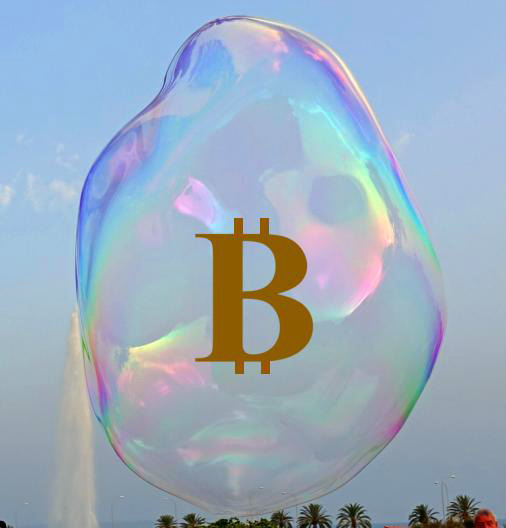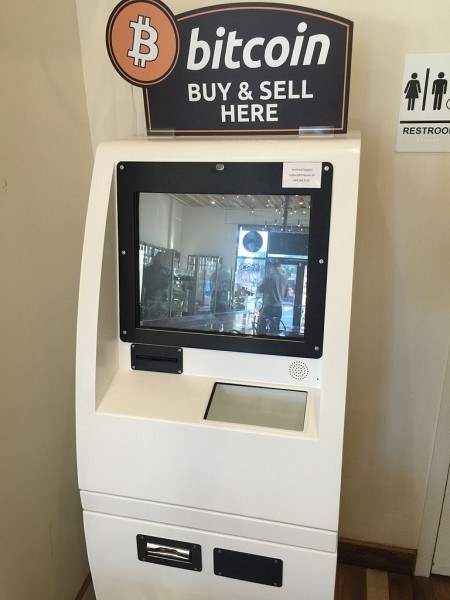Bubbling bitcoin
What do tulips, nickel mining in Australia, South Seas trading, Beanie Babies and cryptocurrencies have in common? The answer is that they have all been the subject of speculative bubbles. In the first four cases the bubble burst. A question currently being asked is whether it will happen to bitcoin.
Bitcoin
 Bitcoin was created in 2009 by an unknown person, or people, using the alias Satoshi Nakamoto. It is a digital currency in the form of a line of computer code. Bitcoins are like ‘electronic cash’ which can be held or used for transactions, with holdings and transactions heavily encrypted for security – hence it is a form of ‘crytocurrency’. People can buy and sell bitcoins for normal currencies as well as using them for transactions. People’s holdings are held in electronic ‘wallets’ and can be accessed on their computers or phones via the Internet. Transfers of bitcoins from one person or organisation to another are recorded in a public electronic ledger in the form of a ‘blockchain‘.
Bitcoin was created in 2009 by an unknown person, or people, using the alias Satoshi Nakamoto. It is a digital currency in the form of a line of computer code. Bitcoins are like ‘electronic cash’ which can be held or used for transactions, with holdings and transactions heavily encrypted for security – hence it is a form of ‘crytocurrency’. People can buy and sell bitcoins for normal currencies as well as using them for transactions. People’s holdings are held in electronic ‘wallets’ and can be accessed on their computers or phones via the Internet. Transfers of bitcoins from one person or organisation to another are recorded in a public electronic ledger in the form of a ‘blockchain‘.
The supply of bitcoins is not controlled by central banks; rather, it is determined by a process known as ‘mining’. This involves individuals or groups solving complex and time-consuming  mathematical problems and being rewarded with a new block of bitcoins.
mathematical problems and being rewarded with a new block of bitcoins.
The supply of bitcoins is currently growing at around 150 per hour and the current supply is around ₿16.7 million. However, the number of new bitcoins in a block is halved for every 210,000 blocks. This means that the rate of increase in the supply of bitcoins is slowing – the number generated being halved roughly every four years. The supply will eventually reach a maximum of ₿21 million, probably sometime in the next century, but around 99% will have been mined by around 2032.
The bitcoin bubble
The price of bitcoins has soared in recent months and especially in the past two. On 4 October, the price of a bitcoin was $4226; by 7 December it was nearly four times higher, at $16,858 – a rise of 399% in just nine weeks. Many people have claimed that this is a bubble, which will soon burst. Already there have been severe fluctuations. By December 10, for example, the price had fallen at one point to $13,152 – a fall of nearly 22% in just two days – only to recover to over $15,500 within a few hours.
So what determines the price of bitcoin? The simple answer is very straightforward – it’s determined by demand and supply. But what has been happening to demand and supply and why? And what will happen in the near and more distant future?
As we have seen, the supply is limited by the process of mining, which allows a relatively stable, but declining, increase. The explanation of the recent price rise and what will happen in the future lies on the demand side. Increasing numbers of people have been buying bitcoin, not because they want to use it for transactions, whether legitimate or illegal over the dark web, but because they want to invest in bitcoin. In other words, they want to hold bitcoin as an asset which is increasing in value. These people are known as ‘hodlers’ – a deliberate misspelling of ‘holders’.
But this speculation is of the destabilising form. The more prices have risen, the more people have bought bitcoin, thus pushing the price up further. This is a classic bubble, whereby the price does not reflect an underlying value, but rather the exuberance of buyers.
 The problem with bubbles is that they will burst, but just when is virtually impossible to predict with any accuracy. If the price of bitcoins falls, what will happen next depends on how the fall is interpreted. It could be interpreted as a temporary fall, caused by some people cashing in to take advantage of the higher prices. At the same time, other people, believing that it is only a temporary fall, will rush to buy, snapping up bitcoins at the temporary low price. This ‘stabilising speculation’ will move the price back up again.
The problem with bubbles is that they will burst, but just when is virtually impossible to predict with any accuracy. If the price of bitcoins falls, what will happen next depends on how the fall is interpreted. It could be interpreted as a temporary fall, caused by some people cashing in to take advantage of the higher prices. At the same time, other people, believing that it is only a temporary fall, will rush to buy, snapping up bitcoins at the temporary low price. This ‘stabilising speculation’ will move the price back up again.
However, the fall in price may be seen as the bubble bursting, with even bigger falls ahead. In this case, people will rush to sell before it falls further, thereby pushing the price even lower. This destabilising speculation will amplify the fall in prices.
But even if the bubble does burst, people may believe that another bubble will then occur and, once they think the bottom has been reached, will thus start buying again and there will be a second speculative rise in the price.
The crash could be very short-lived. This happened with the second biggest cryptocurrency, Ethereum. On 21 June this year, the price at the beginning of the day was $360. It then began to fall during the say. Once its price reached $315, it then collapsed by 96% to $13 with massive selling, much of it automatic with computers programmed to sell when the price falls by more than a certain amount. But then, on the same day, it rebounded. Within minutes it had bounced back and was trading at $337 at the end of the day. It is now trading at around $450 – up from around $300 four weeks ago.
Whether the bubble in bitcoin has more to inflate, when it will burst, and when it will rebound and by how much, depends on people’s expectations. But what we are looking at here is people’s expectations of what other people are likely to do – in other words, of other people’s expectations, which in turn depend on their expectations of other people’s expectations. This situation is known as a Keynesian Beauty Contest (see the blog, A stock market beauty contest of the machines). Perhaps we need a crystal ball.
Information site
- What is Cryptocurrency?
Crypto Coin society, Jesus Cedeño
Articles
- Is Bitcoin a bubble? Here’s what two bubble experts told us
- Bitcoin and tulipmania have a lot more in common than you might think
- Bitcoin ends dramatic week with 20% slump followed by recovery
- Putting a price on Bitcoin
- Is Bitcoin a Bubble Waiting to Pop?
- Bitcoin bubble follows classic pattern of investment mania
- The Bitcoin bubble – how we know it will burst
- Bitcoin isn’t a currency – and unless it becomes one it could be worthless
- How Bitcoin futures trading could burst the cryptocurrency’s bubble
- Op-ed: Bitcoin Is Not a Bubble; It’s in an S-Curve and It’s Just Getting Started
- Bitcoin vs history’s biggest bubbles: They never end well
- The 10 Most Ridiculous Price Bubbles In History
- After bitcoin’s wild week, traders brace for futures launch
Trade Online, Timothy B. Lee (8/12/17)
Business Insider, Seth Archer (8/12/17)
The Guardian, Jill Treanor (8/12/17)
The Economist, Buttonwood’s notebook (8/12/17)
InvestorPlace, Matt McCall (8/12/17)
Financial Times, John Authers (8/12/17)
The Conversation, Larisa Yarovaya and Brian Lucey (6/12/17)
The Conversation, Vili Lehdonvirta (6/12/17)
The Conversation, Nafis Alam (13/12/17)
Bitcoin Magazine, Brandon Green (8/12/17)
CNN Money, Daniel Shane (8/12/17)
Business Insider, Vincent Fernando and Anika Anand (11/10/10)
Reuters, Saqib Iqbal Ahmed (10/12/17)
Cryptocurrencies current market prices
- Bitcoin live exchange prices and volumes ($)
- All cryptocurrencies – live market prices
CryptoCompare
Yahoo Finance
Questions
- To what extent does Bitcoin meet the functions of money?
- Why is bitcoin unsuitable for normal transactions?
- To what extent is bitcoin like gold as a means of holding wealth?
- How would you advise someone thinking of buying bitcoin today? Explain why.
- Does a rapid rise in the price of an asset always indicate a bubble? Explain
- To what extent is the current rise in the price of bitcoin similar to that of the tulip, Poseidon and Beanie Baby bubbles?
- If bitcoin is appreciating relative to the dollar and other currencies, does this mean that the price of goods and services valued in bitcoin are falling? Explain.
- Explain and comment on the following sentence from the first Conversation article: “Like any asset, Bitcoin has some fundamental value, even if only a hope value, or a value arising from scarcity.”
- How might the introduction of futures trading in bitcoin impact on its price and the volatility of price swings?
- Explain and assess the argument that the price trend of bitcoin is more likely to be an S curve rather than a roller coaster